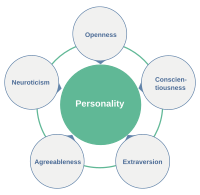
Photo from wikipedia
Abstract The extent to which genetic aetiologies are shared between traits and disorders naturally depends on the genetic composition of the two phenotypes. While psychiatric disorders are diagnostic entities, defined… Click to show full abstract
Abstract The extent to which genetic aetiologies are shared between traits and disorders naturally depends on the genetic composition of the two phenotypes. While psychiatric disorders are diagnostic entities, defined by diagnostic criteria including the age of onset, human behaviour changes continuously during development. Studying the genetic overlap between psychiatric illness and social-communication difficulties across multiple developmental stages, we identified, for example, distinct developmental profiles for childhood- versus adult-onset psychiatric disorders respectively. The genetic overlap between clinical ASD and social-communication difficulties during childhood, declined with progressing age of the trait, while the genetic overlap between clinical schizophrenia and social-communication problems was strongest for traits during later adolescence. Thus, the risk of developing these contrasting psychiatric conditions might be related to distinct sets of genes, both of which influence social communication skills, but exert their maximum influence during different periods of development. This suggests complex developmental modifications of the underlying genetic trait architecture. We have now developed a multivariate analysis framework in unrelated individuals to assess the developmental profile of genetic influences that contribute to phenotypic variation during childhood and adolescence. This analysis combines whole-genome genotyping information in unrelated individuals with structural equation modelling techniques (Genetic-relationship-matrix structural equation models, GSEM). Analogous to multivariate twin research, multivariate GSEM can include Cholesky decomposition models, common pathway models or independent pathway model, among many others. Using standard model fitting procedures, we could show that a Cholesky decomposition model, specifying two distinct genetic factors arising during childhood, fitted, for example, developmental changes in social communication abilities best. One genetic factor was common to social communication problems across development spanning 8 to 17 years (path coefficients: 0.20 to 0.54, based on standardised measures). The other factor accounted for independent phenotypic variation arising at 11 years and later ages (path coefficients: 0.20 to 0.44, based on standardised measures). Thus, genetic factors operating during mid-childhood only accounted for a limited proportion (~60%) of genetic variation at age 17 years. These incremental changes in genetic factors influencing social-communication difficulties during child and adolescent development are consistent with distinct developmental trait profiles in genetic overlap with psychiatric illness. An understanding of developmental variations in complex genetic trait architectures is therefore important for studies investigating the continuity of psychiatric disorders.
Journal Title: European Neuropsychopharmacology
Year Published: 2019
Link to full text (if available)
Share on Social Media: Sign Up to like & get
recommendations!